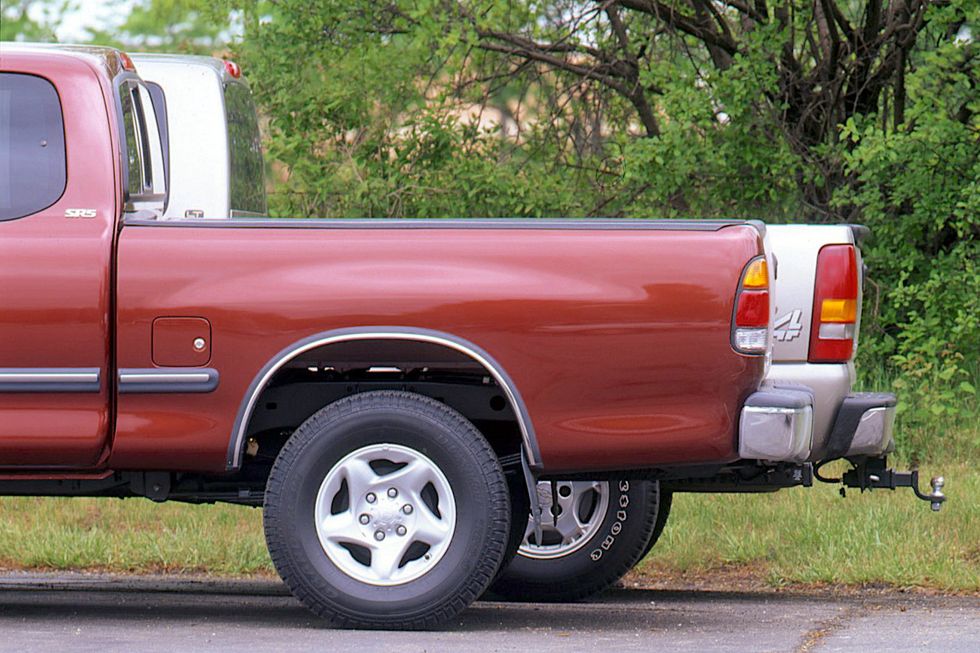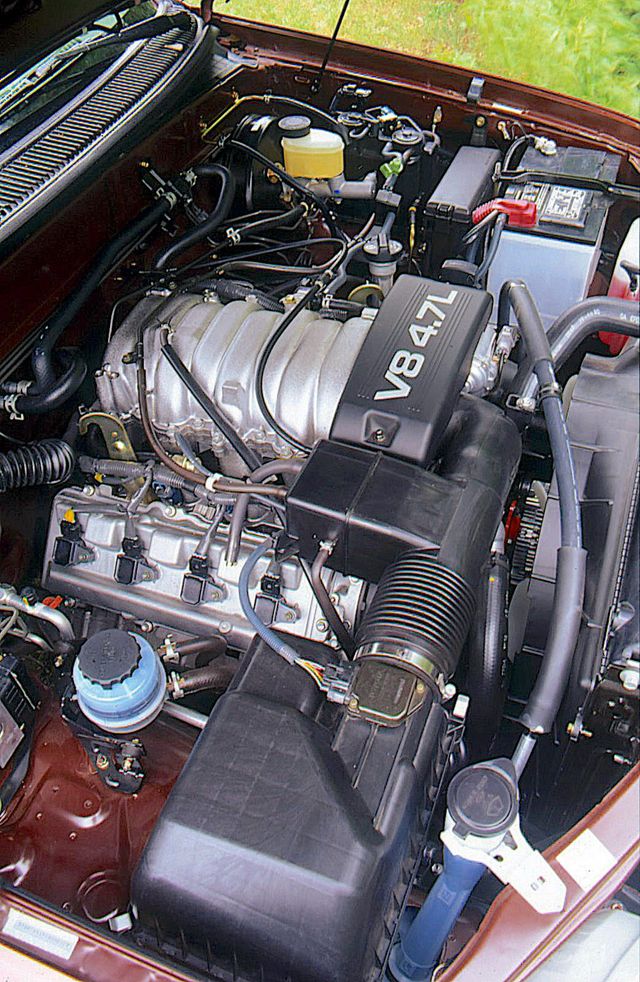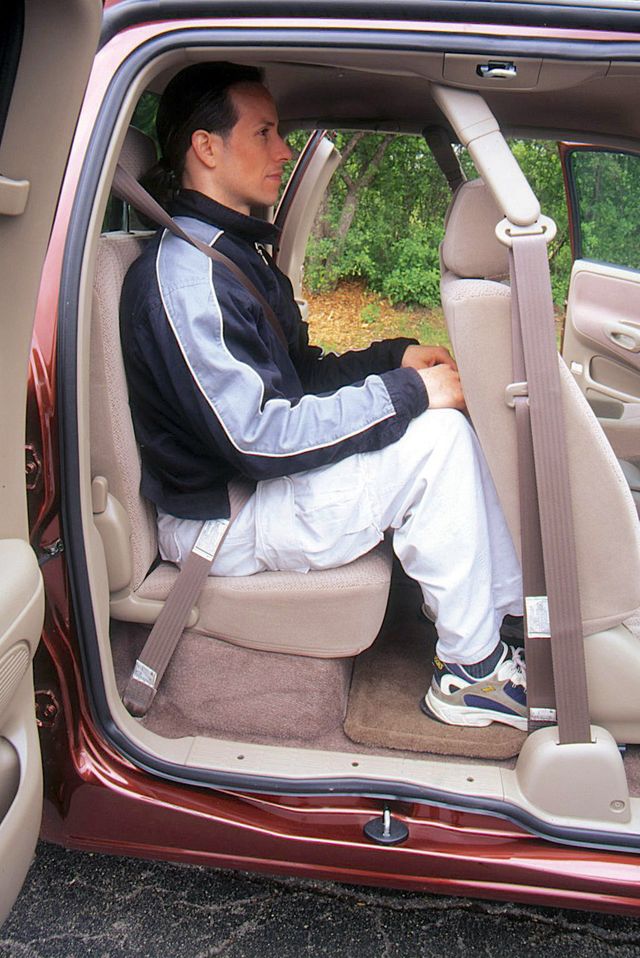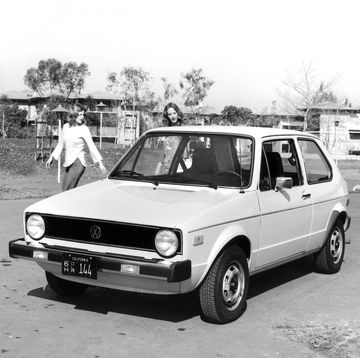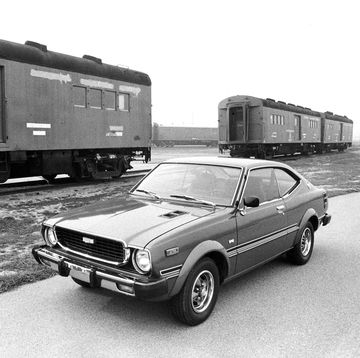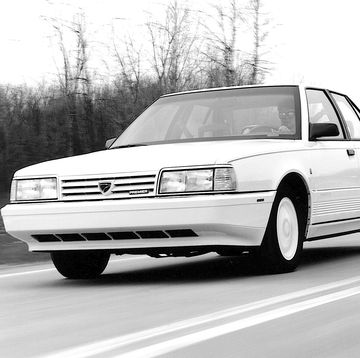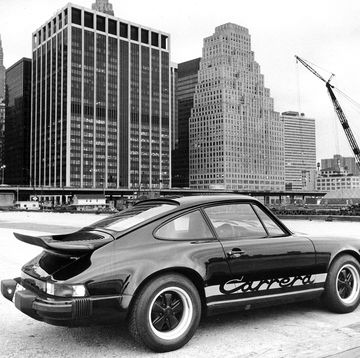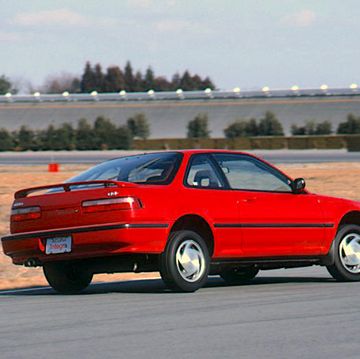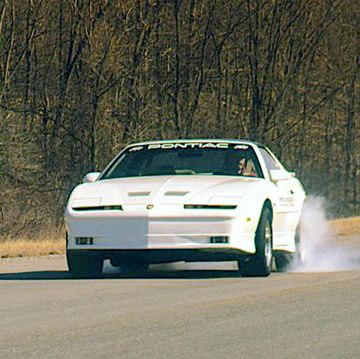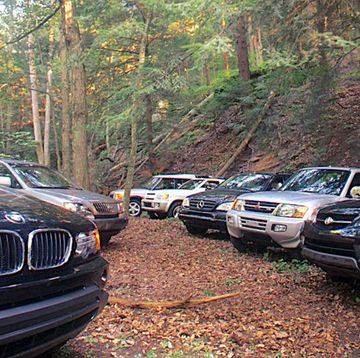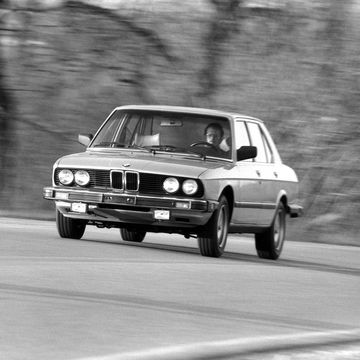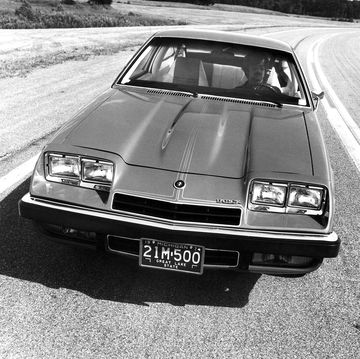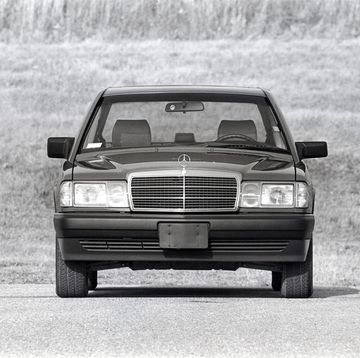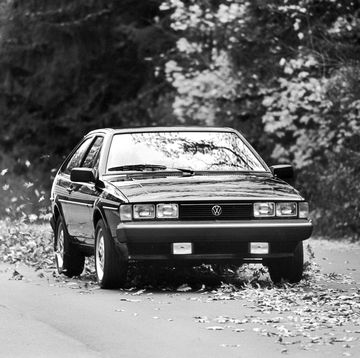From the August 1999 issue of Car and Driver.
The grim death of a family of javelinas in 1993 should have tipped me off to the fact that Toyota would eventually get its big pickup truck right.
I can explain.
Several automotive writers were driving Toyota products down the long desert road that leads to Toyota's Arizona proving ground. I was in the lead, driving a then-new T100 pickup, with a freshly minted Toyota executive riding shotgun.
Suddenly, out of the scrub brush on my left, a big mother javelina—a desert pig—appeared, with several piglets. They started across the gravel road. I jammed on the brakes—we were going about 75 mph—and the javelinas stopped in their tracks at the edge of the road. I hit the accelerator again, hoping to clear them before they changed their minds.
I was unsuccessful. They started across the road again. The mother javelina—about a 25-pounder, I'd say—made a fatal impact with the right-front lower control arm. The remainder of the family was pretty much made extinct by the Previa minivan on my rear bumper, and whoever was behind it.
I mention this unpleasantness because of what happened next. As we reached the Toyota facility moments later, word quickly spread that there had been a T100-meets-javelina incident. Japanese engineers appeared from nowhere. They crawled under the T100 and inspected the undamaged front suspension, took pictures, made notes, plucked javelina fur with tweezers. It was weird.
That sort of attention to detail—a Toyota trademark—certainly suggests a company that fixes stuff that doesn't work. It has fixed what didn't work on the T100, but that took six years. The upshot, though: The Toyota Tundra, the successor to the T100, is finally ready, willing, and able to challenge full-size American-branded pickups on their own turf.
It's one of the more interesting automotive stories of the past decade: how pickup sales have continued to dominate the list of the top-10 bestselling vehicles, but how the Japanese manufacturers have retreated from the market. Mitsubishi no longer sells pickups. Isuzu's pickups are built by GM; Mazda's, by Ford. Odd, isn't it? Isuzu once built pickups for Chevy (the LUV), and Mazda for Ford (the Courier).
The slab-sided T100 was introduced with a 150-horsepower, 3.0-liter V-6 that supposedly could tow 5000 pounds, presumably downhill. By the time Toyota fine-tuned the T100 and added the very capable 190-hp, 3.4-liter V-6—now the standard engine in the Tundra—and cured the T100's slab-sidedness with an extended-cab model, it was too late. Serious pickup buyers had already written off the Toyota.
So Toyota took some time off, retiring the T100 in order to get a brand-new plant in Indiana up and running. If all goes as planned, the $1.2 billion plant will build 100,000 Tundras a year and another 50,000 SUVs based on the Tundra platform that should go on sale in late 2000.
Apparently, Toyota would just as soon hope we all forget the T100. A 53-page press kit on the Tundra makes only two very brief mentions of the truck that came before it—one notes that the Tundra's wheelbase is 6.5 inches longer than a T100's, and the other says the Tundra has 23 percent greater cooling capacity.
Just as well. Our Tundra access-cab SR5 test truck spoke quite capably for itself.
It is quite a bit smaller than, say, the GMC Sierra Z71 extended-cab pickup that won our truck comparo in October 1998. The GMC is about 10 inches longer, 2.6 inches taller, and a couple hundred pounds heavier. The GMC's 143.5-inch wheelbase is 15.2 inches longer.
Our four-wheel-drive Tundra's 7100-pound towing capacity is 400 pounds shy of the four-wheel-drive GMC's. With similar equipment, the price is comparable. Although our Tundra crowded $30,000, Toyota made good on its promise to price the bare-bones Tundra at less than $15,000—$14,995, to be exact, plus a $420 destination fee.
The Tundra holds its own in performance largely because of the 32-valve, 245-hp, 4.7-liter DOHC V-8 borrowed from the Land Cruiser, and because of a perceptive, quick-shifting four-speed automatic transmission.
The Tundra hit 60 mph in 8.5 seconds, compared with 9.0 seconds in the GMC, which was powered by the 270-hp, 5.3-liter pushrod V-8. The Toyota covered the quarter-mile in 16.6 seconds at 83 mph, a little quicker than the Sierra's 17.0 seconds at 81 mph. The Tundra was governed to 105 mph, the GMC to 98 mph.
The Tundra stopped much quicker from 70 mph, taking just 201 feet, 18 fewer than the GMC. Neither set the skidpad on fire, with the Toyota taking the 300-foot circle at 0.72 g, the Sierra at 0.68 g.
One area where the Tundra does stand out is how quietly it goes about its business. The only engine noise is the V-8's muted exhaust note, despite the fact that no underhood sound-deadening pad is used or needed. The P265/70SR-16 Dunlop TG35 Grandtrek radials did their part to maintain silence, despite their adequate off-road capability.
Handling is surprisingly neutral for a four-wheel-drive pickup, and the ride, even on rough pavement, is quite good. The suspension is hardly cutting edge—live axle with leaf springs at the rear, coil springs and javelina-resistant control arms up front—but the execution is impressive. The front-disc, rear-drum brakes have a sure, progressive feel. ABS is a $630 option, part of a package that includes, oddly, daytime running lights.
Inside, the cockpit is simple and functional, with an ovoid control panel containing knobs and switches and a compact AM/FM-stereo/cassette system with a six-disc CD changer. If you feel at home in almost any Toyota—or Lexus, for that matter—you'll be at home in the driver's seat of the Tundra SR5.
You'll be less at home in the rear seat. Although the "suicide" doors on each side make access easy, the hopelessly upright rear seat is miserable. Legroom is minimal—that is to be expected—but the rear seat is so uncomfortable for adults that this must be viewed as the Single Glaring Error in the Tundra's development. That said, we suppose it's passable for kids, and the fact that it's a 60/40 seat bottom, with either side able to flip up to increase rear-seat storage space, adds points. The jack is beneath the "40" seat, and a purse-size storage compartment is under the "60" side. A center armrest flips down for rear passengers and offers them two cup holders—there are four up front, along with three power outlets.
Otherwise, the Tundra is conventional Toyota, which means it feels rock solid. The only chink in that armor was the electronic transfer case, which at times seemed balky shifting into and out of two-wheel drive and four-wheel-drive high, and downright clunky when—stopped, and in neutral—asked to shift to four-wheel-drive low. Eventually, it gave up and refused to shift into four-wheel drive at all, made known by constant blinking of two separate lights. At this writing, we haven't heard the diagnosis.
We're willing to chalk that up to an early-production truck that had already suffered through at least one media thrash, but the problem continues our mixed experience with electronic transfer cases. It may be a pain to yank on a manual transfer lever, but there's less that can go wrong.
Truck owners may be the most loyal customers there are, and Toyota realizes that if it is to sell 100,000 Tundras a year, it will have to pick up some buyers from Ford, Chevrolet, GMC, and Dodge. Finally, Toyota has a good enough truck to compete.
Counterpoint
If refinement—not space—is the final frontier in the pickup-truck realm, then Toyota is positioned for intergalactic domination with the new Tundra. Its doors shut with a pleasing thud, its suspension glides silently over pock-marked pavement, its LS400-derived V-8 sings a soft soothing song, and its rock-solid feel speaks of long-lasting refinement. But then U.S. pickup truckers haven't demonstrated much interest in refinement, and they may be put off by the nameplate, the four-wheel-drive system's lack of an automatic mode, the tiny back seat, or the simple fact that the Tundra just ain't as big. Among truckers, for whom size does matter, space may still be the final frontier. —Frank Markus
The Toyota Tundra is smooth, quiet, and comfortable. If you close your eyes while driving a Tundra (not like I ever did this), you might even think you were in a Camry. But the Tundra is not a lightweight: It can haul about 1500 pounds of payload and tow 7100 pounds. Is this the truck formula that loyal meat-and-potato F-150/Sierra/Ram buyers want? According to Toyota, Tundra buyers will be newcomers to the full-size-pickup market, Tacoma owners who want something bigger, and truck buyers who don't care what brand they buy. They won't be F-150/Sierra/Ram defectors. I say, too bad. They're missing out on a hell of a nice, and useful, truck. —Bradley Nevin
I can't stop doing it, looking in the window of the few Toyota T100s I see on the road to catch a glimpse of the person who actually bought one—someone presumably making payments on Toyota's underpowered, egg-shaped, first-try-at-a-full-size pickup. I'm embarrassed by my compulsion. But now the weirdness comes to an end, as the Tundra makes perfect sense. It's a Camry on the inside and an F-150 outside, as Toyota took the best features from the bestselling vehicles for the Tundra. And then there's the four-cam V-8 that would improve anybody's truck. Tundra buyers need make no apologies. This one's going to work. —Jim Scoutten
Specifications
Specifications
1999 Toyota Tundra SR5 V-8 4x4 Access Cab
Vehicle Type: front-engine, 4-wheel-drive, 5-passenger, 2+2-door pickup
PRICE
Base/As Tested: $26,005/$29,548
Options: Convenience package (power windows, locks, and mirrors; sliding rear window; lighting package), $1060; anti-lock brakes with daytime running lights, $630; aluminum wheels and chrome wheel-arch moldings, $600; trailer hitch, $379; bedliner, $299; AM/FM-stereo radio/cassette/CD player, $250; fog lamps, $100; floor mats, $80; cloth captain's chairs, $75; All-Weather Guard package (heavy-duty battery, heater, and starter), $70
ENGINE
DOHC 32-valve V-8, iron block and aluminum heads, port fuel injection
Displacement: 285 in3, 4664 cm3
Power: 245 hp @ 4800 rpm
Torque: 315 lb-ft @ 3400 rpm
TRANSMISSION
4-speed automatic
CHASSIS
Suspension, F/R: control arms/rigid axle
Brakes, F/R: 12.6-in vented disc/11.6-in cast-iron drum
Tires: Dunlop TG35 Grandtrek
265/70SR-16
DIMENSIONS
Wheelbase: 128.3 in
Length: 217.5 in
Width: 79.3 in
Height: 71.3 in
Passenger Volume, F/R: 60/40 ft3
Cargo Volume: 45 ft3
Curb Weight: 4707 lb
C/D TEST RESULTS
60 mph: 8.5 sec
1/4-Mile: 16.6 sec @ 83 mph
100 mph: 26.9 sec
Rolling Start, 5–60 mph: 8.7 sec
Top Gear, 30–50 mph: 4.2 sec
Top Gear, 50–70 mph: 5.6 sec
Top Speed (gov ltd): 105 mph
Braking, 70–0 mph: 201 ft
Roadholding, 300-ft Skidpad: 0.72 g
C/D FUEL ECONOMY
Observed: 14 mpg
EPA FUEL ECONOMY
City/Highway: 14/17 mpg



